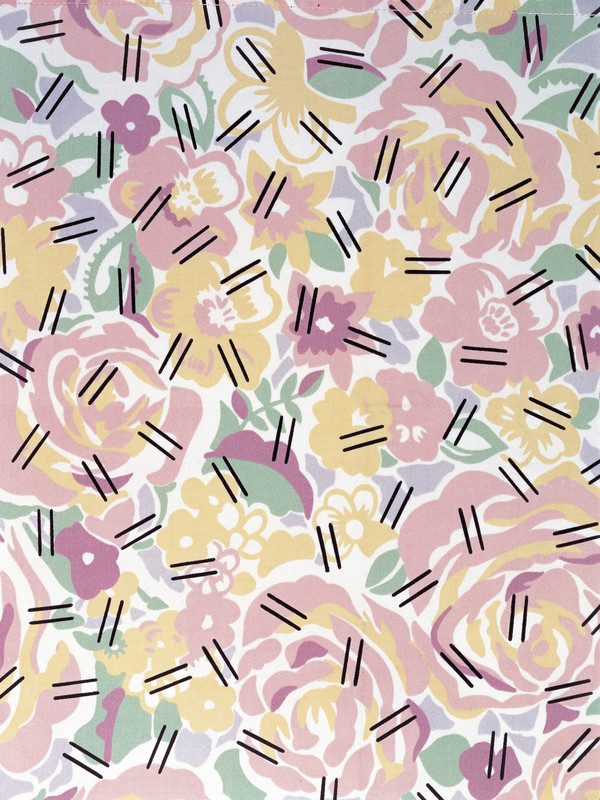Lesson 1: Pattern Collages
Artists-in-Residence at The Fabric Workshop and Museum often use new media and combine traditional printmaking techniques with commercial ones. However unique their materials and methods, these artists rely on the elements and principles of design in order to attract our attention and communicate their ideas. The following activity can be implemented as a stand alone lesson, or as part of a larger unit of study.
Objectives
- Students will look at, think about, and discuss contemporary art and design.
- Students will think creatively and critically about how repetition, contrast, pattern and rhythm contribute to a dynamic, contemporary design.
- Students will create collages using large and small shapes, light and dark colors, and organic and geometric shapes to form a multi-layered pattern.
Materials and Resources
- Photographs of Grandmother by Robert Venturi. (See An Industrious Art: Innovation in Pattern and Print at The Fabric Workshop, edited by Marion Boulton Stroud, pages 25 – 27)
- Scissors
- White glue
- Brushes (for glue)
- Pre-cut pieces of colored paper or fabric (light and dark colors, small and large sizes)
- Pieces of colored fabric or construction paper (8 1/2″ x 11″)
Activities
- As a class, brainstorm how we experience patterns in everyday life. Consider daily rituals (brushing teeth, eating meals, taking the bus) and objects (china, clothing, game boards).
- Together, view and discuss photographs of Grandmother, a pattern that Robert Venturi created and used on a banner and a chair.
- Which shapes are large? Small? Light? Dark? Organic? Geometric?
- Which shapes, sizes, and colors are repeated?
- What parts of the design seem close to us? Farther away?
- Do you think these shapes and colors are hard or soft? Loud or quiet? Why?
- Do you see any movement in this design? How would you describe it?
- Why do you think the artist, Robert Venturi, named this pattern Grandmother?
- Show and discuss FWM videos of Robert Venturi. Share background information on Grandmother and the artist.
- Help students create collage patterns:
- Divide the class in half. Have students in one group draw and cut out geometric shapes (dark and light colors, small and large shapes) while the other group draws and cuts out organic shapes (dark and light colors, small and large shapes).
- Help students measure and draw grids on colored paper or fabric. (Provide pre-drawn grids on paper for younger students.)
- Encourage students to experiment with arranging the cutout shapes on the grids, combining the sizes, colors and types of shapes and colors to form multi-layered patterns.
- Have students glue their patterns onto fabric or paper.
Reflection and Evaluation
- Display the “Pattern and Rhythm” collages.
- As a class, discuss the visual rhythms created by the types and sizes of shapes, lights and darks, and use of repetition in their collages.
- Have students choose what kind of object their pattern could decorate, for example a chair, tablecloth, knap sack.
- Give examples of rhyming sentences and phrases and have students write short poems about their designs using descriptive words and rhyming phrases.
National Standards
- Content Standard #1 (Understanding and applying media, techniques, and processes)
- Content Standard #2 (Using knowledge of structures and functions)
- Content Standard #3 (Choosing and evaluating a range of subject matter, symbols, and ideas)
- Content Standard #5 (Reflecting upon and assessing the characteristics and merits of their work and the work of others)
- Content Standard #6 (Making connections between visual arts and other disciplines)
Vocabulary
- Collage: A work of art made by arranging and gluing pictures, photographs, fabrics, and/or found materials to a surface.
- Composition: Arrangement of the formal elements (color, shape, line, texture) in an artwork.
- Organic: Adjective describing irregular shapes that resemble or suggest shapes found in nature.
- Geometric: Adjective describing straight or curvy lines and shapes similar to those used in geometry.
- Pattern: Decorative design made of repeated shapes, lines, and colors.
- Parallel: Extending in the same direction, equidistant at all points, and never converging.
- Rhythm: Repetition of a motif or formal element at regular or irregular intervals (regular rhythm or random rhythm) in a design or work of art.
Curriculum Connections
- Language Arts
Read and discuss A Chair for My Mother, a Caldecott Honor picture book written and illustrated by Vera B. Williams, noting the patterns in the illustrations and the repeating colors and shapes that form patterns in the borders of each page. - Math
What math symbol do you think of when you look at the black dashes on the design? How many big roses do you see in this pattern? - Social Studies
Discuss the variety of things that are mass-produced (manufactured in large quantities in an assembly line). What is the opposite of mass-produced? Brainstorm lists of objects that are mass-produced and hand-made. - Science
Robert Venturi and his colleagues call the pairs of parallel lines in Grandmother “ants” because they are placed in an orderly yet random arrangement. Research how real, individual ants communicate with each other to work together in a random yet organized way. - Art
Find several used, wooden chairs. Have students prepare, design, and paint patterns on them.
